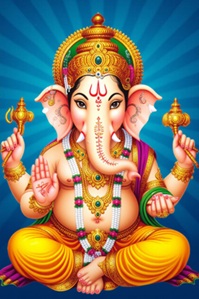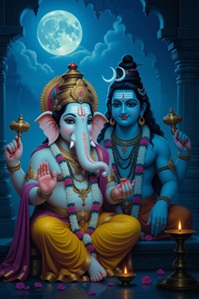Discover the history of Ganesh Chaturthi, its origin, significance, and why we celebrate it with devotion, unity, and eco-friendly traditions.
Ganesh Chaturthi is one of the most loved and widely celebrated festivals in India. Every year, millions of devotees welcome Lord Ganesha, the remover of obstacles, into their homes and communities with devotion, music, sweets, and rituals. But have you ever wondered about the history of Ganesh Chaturthi? Why do we celebrate this festival with so much joy and grandeur? Let us dive into the story behind this auspicious occasion and understand its significance.

Who is Lord Ganesha?
Lord Ganesha, also known as Ganpati or Vinayaka, is the son of Lord Shiva and Goddess Parvati. He is easily recognized by his elephant head, big belly, and kind smile. Ganesha is called Vighnaharta, the remover of obstacles, and Buddhividhata, the giver of wisdom and intelligence. That is why people begin every new journey, business, or puja with his blessings.
Origin of Ganesh Chaturthi
The history of Ganesh Chaturthi goes back thousands of years. According to Hindu scriptures, the festival marks the birth of Lord Ganesha. It is believed that Goddess Parvati created him out of sandalwood paste to guard her while she bathed. When Lord Shiva returned and tried to enter, Ganesha stopped him. This led to a battle in which Shiva unknowingly beheaded him. Seeing Parvati’s sorrow, Shiva promised to bring him back to life. He replaced Ganesha’s head with that of an elephant and blessed him to be worshiped first among all gods.
From that day onwards, Ganesha became the symbol of new beginnings and wisdom. To honor his birth, people started celebrating Ganesh Chaturthi every year during the Hindu month of Bhadrapada (August-September).
Ganesh Chaturthi in Ancient India
Ganesh Chaturthi was initially celebrated privately by families and small communities. Historical records show that during the time of the Satavahana, Rashtrakuta, and Chalukya dynasties (around 3rd to 12th century), the festival was observed with rituals and offerings. Ancient temples of Maharashtra and Karnataka have carvings of Lord Ganesha, proving his deep connection with Indian culture.
Revival by Lokmanya Tilak
The large-scale public celebration of Ganesh Chaturthi that we see today was started by Lokmanya Bal Gangadhar Tilak in the late 19th century. During British rule, gatherings of people were restricted to avoid revolts. Tilak realized that the devotion towards Lord Ganesha could unite people beyond caste and community.
In 1893, he transformed Ganesh Chaturthi from a private household festival into a public celebration. Pandals were set up, processions were organized, and people came together to worship Ganesha. This movement played a huge role in creating unity and patriotic spirit among Indians during the freedom struggle.
Because of this revival, Ganesh Chaturthi became not just a religious festival but also a cultural and social gathering. Even today, the tradition continues with grandeur in states like Maharashtra, Karnataka, Goa, and across the world wherever Indian communities live.
Why Do We Celebrate Ganesh Chaturthi?
Ganesh Chaturthi is celebrated for several reasons, both spiritual and cultural:
- To seek blessings of Lord Ganesha – Devotees worship him to remove obstacles and bring success, prosperity, and wisdom.
- To honor traditions – The festival reminds us of our cultural roots and ancient stories of Hindu dharma.
- To spread unity – Just like Tilak’s movement, the festival brings people together beyond caste, creed, or religion.
- To celebrate eco-friendly practices – In modern times, many people choose clay idols and natural decorations to protect the environment.
- To welcome positivity – The presence of Lord Ganesha in homes and pandals spreads joy, music, devotion, and togetherness.

How Ganesh Chaturthi is Celebrated
The festival usually lasts for 10 days, starting with Ganesh Sthapana (idol installation) on the first day and ending with Ganesh Visarjan (immersion) on the last day.
- Day 1 (Ganesh Sthapana): Devotees bring idols of Lord Ganesha to their homes or pandals with rituals, chanting, and prayers.
- Daily Puja: Offerings of flowers, durva grass, modak (a sweet dumpling), and fruits are made. Aartis are performed every morning and evening.
- Community Celebrations: In many places, cultural programs, devotional singing, and plays are organized.
- Day 10 (Ganesh Visarjan): The idols are immersed in water bodies with chants of “Ganpati Bappa Morya, Pudhchya Varshi Lavkar Ya” (O Lord Ganesha, come again early next year). This symbolizes the cycle of birth, life, and dissolution.
Ganesh Chaturthi Today
In modern times, Ganesh Chaturthi is celebrated not only in India but also in countries like the USA, UK, Canada, and Singapore where Indian communities live. The festival has also become a global symbol of Indian culture. With growing awareness about the environment, people now prefer eco-friendly clay idols and natural colors instead of plaster of Paris and chemical paints.
Conclusion
The history of Ganesh Chaturthi shows how a festival rooted in devotion transformed into a movement of unity, culture, and celebration. From ancient rituals to Lokmanya Tilak’s revival during the freedom struggle, Ganesh Chaturthi holds a special place in the hearts of millions.
We celebrate Ganesh Chaturthi not just to worship Lord Ganesha but also to bring positivity, harmony, and wisdom into our lives. Every year, when we chant “Ganpati Bappa Morya”, we welcome hope, prosperity, and togetherness.
As we prepare for Ganesh Chaturthi 2025, let us remember its true essence — devotion with responsibility, joy with eco-friendliness, and celebration with unity.